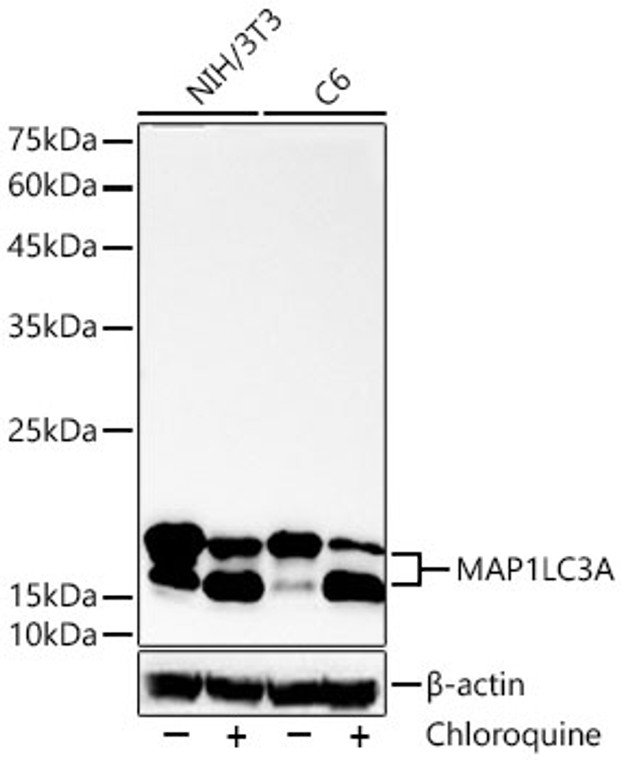| Host: |
Rabbit |
| Applications: |
WB/IP |
| Reactivity: |
Human |
| Note: |
STRICTLY FOR FURTHER SCIENTIFIC RESEARCH USE ONLY (RUO). MUST NOT TO BE USED IN DIAGNOSTIC OR THERAPEUTIC APPLICATIONS. |
| Short Description: |
Rabbit monoclonal antibody anti-MAP1LC3A (1-100) is suitable for use in Western Blot and Immunoprecipitation research applications. |
| Clonality: |
Monoclonal |
| Clone ID: |
S5MR |
| Conjugation: |
Unconjugated |
| Isotype: |
IgG |
| Formulation: |
PBS with 0.02% Sodium Azide, 0.05% BSA, 50% Glycerol, pH7.3. |
| Purification: |
Affinity purification |
| Dilution Range: |
WB 1:500-1:1000IP 1:50-1:1200 |
| Storage Instruction: |
Store at-20°C for up to 1 year from the date of receipt, and avoid repeat freeze-thaw cycles. |
| Gene Symbol: |
MAP1LC3A |
| Gene ID: |
84557 |
| Uniprot ID: |
MLP3A_HUMAN |
| Immunogen Region: |
1-100 |
| Immunogen: |
A synthetic peptide corresponding to a sequence within amino acids 1-100 of human MAP1LC3A (Q9H492). |
| Immunogen Sequence: |
MPSDRPFKQRRSFADRCKEV QQIRDQHPSKIPVIIERYKG EKQLPVLDKTKFLVPDHVNM SELVKIIRRRLQLNPTQAFF LLVNQHSMVSVSTPIADIYE |
| Tissue Specificity | Most abundant in heart, brain, liver, skeletal muscle and testis but absent in thymus and peripheral blood leukocytes. |
| Post Translational Modifications | The precursor molecule is cleaved by ATG4 (ATG4A, ATG4B, ATG4C or ATG4D) to expose the glycine at the C-terminus and form the cytosolic form, LC3-I. The processed form is then activated by APG7L/ATG7, transferred to ATG3 and conjugated to phosphatidylethanolamine (PE) phospholipid to form the membrane-bound form, LC3-II. During non-canonical autophagy, the processed form is conjugated to phosphatidylserine (PS) phospholipid. ATG4 proteins also mediate the delipidation of PE-conjugated forms. In addition, ATG4B and ATG4D mediate delipidation of ATG8 proteins conjugated to PS during non-canonical autophagy. ATG4B constitutes the major protein for proteolytic activation. ATG4D is the main enzyme for delipidation activity. (Microbial infection) The Legionella effector RavZ is a deconjugating enzyme that hydrolyzes the amide bond between the C-terminal glycine residue and an adjacent aromatic residue in ATG8 proteins conjugated to phosphatidylethanolamine (PE), producing an ATG8 protein that is resistant to reconjugation by the host machinery due to the cleavage of the reactive C-terminal glycine. RavZ is also able to mediate delipidation of ATG8 proteins conjugated to phosphatidylserine (PS). Phosphorylation at Ser-12 by PKA inhibits conjugation to phosphatidylethanolamine (PE). |
| Function | Ubiquitin-like modifier involved in formation of autophagosomal vacuoles (autophagosomes). While LC3s are involved in elongation of the phagophore membrane, the GABARAP/GATE-16 subfamily is essential for a later stage in autophagosome maturation. Through its interaction with the reticulophagy receptor TEX264, participates in the remodeling of subdomains of the endoplasmic reticulum into autophagosomes upon nutrient stress, which then fuse with lysosomes for endoplasmic reticulum turnover. |
| Protein Name | Microtubule-Associated Proteins 1a/1b Light Chain 3aAutophagy-Related Protein Lc3 AAutophagy-Related Ubiquitin-Like Modifier Lc3 AMap1 Light Chain 3-Like Protein 1Map1a/Map1b Light Chain 3 AMap1a/Map1b Lc3 AMicrotubule-Associated Protein 1 Light Chain 3 Alpha |
| Database Links | Reactome: R-HSA-1632852Reactome: R-HSA-5205685Reactome: R-HSA-8934903 |
| Cellular Localisation | Cytoplasmic VesicleAutophagosome MembraneLipid-AnchorEndomembrane SystemCytoplasmCytoskeletonLc3-Ii Binds To The Autophagic Membranes |
| Alternative Antibody Names | Anti-Microtubule-Associated Proteins 1a/1b Light Chain 3a antibodyAnti-Autophagy-Related Protein Lc3 A antibodyAnti-Autophagy-Related Ubiquitin-Like Modifier Lc3 A antibodyAnti-Map1 Light Chain 3-Like Protein 1 antibodyAnti-Map1a/Map1b Light Chain 3 A antibodyAnti-Map1a/Map1b Lc3 A antibodyAnti-Microtubule-Associated Protein 1 Light Chain 3 Alpha antibodyAnti-MAP1LC3A antibody |
Information sourced from Uniprot.org
12 months for antibodies. 6 months for ELISA Kits. Please see website T&Cs for further guidance








![Western blot analysis of various lysates using [KO Validated] MEK2 Rabbit monoclonal antibody (STJ11101615) at 1:1000 dilution. Secondary antibody: HRP Goat Anti-Rabbit IgG (H+L) (STJS000856) at 1:10000 dilution. Lysates/proteins: 25 Mu g per lane. Blocking buffer: 3% nonfat dry milk in TBST. Detection: ECL Basic Kit. Exposure time: 1s. Western blot analysis of various lysates using [KO Validated] MEK2 Rabbit monoclonal antibody (STJ11101615) at 1:1000 dilution. Secondary antibody: HRP Goat Anti-Rabbit IgG (H+L) (STJS000856) at 1:10000 dilution. Lysates/proteins: 25 Mu g per lane. Blocking buffer: 3% nonfat dry milk in TBST. Detection: ECL Basic Kit. Exposure time: 1s.](https://cdn11.bigcommerce.com/s-zso2xnchw9/images/stencil/300x300/products/90529/360110/STJ11101615_1__89635.1713124721.jpg?c=1)
